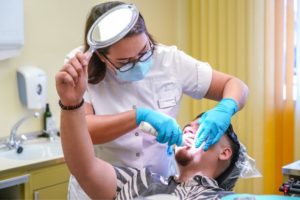Wisdom teeth extraction is a common dental procedure some people experience.
While the procedure is relatively straightforward, the recovery process can be more complex.

One of the common questions people have after wisdom teeth removal is when they can start running again.
Physical activity is vital for overall health and well-being, but taking the appropriate precautions after oral surgery is essential.
In this article, we’ll explore all you need to know about running after wisdom teeth removal.
Which includes when it’s safe to resume exercise and how to prepare for a run.
Also, tips for a smooth recovery to promote healing and minimize the risk of complications.
Is It a Good Idea to Run After Wisdom Teeth Removal?
Running after wisdom teeth removal can be good if done safely and correctly.
However, it’s essential to follow your dentist or oral surgeon’s postoperative instructions.
Then, wait until you are fully healed before resuming physical activity.
Running too soon after wisdom teeth removal can increase the risk of bleeding, swelling, and other postoperative complications.
Give your body enough time to heal before engaging in high-impact activities, including running.
Once fully healed, running can be a great way to stay active and maintain your overall health.
It’s important to start slowly and gradually increase your intensity to avoid injury or complications.
You should also protect the extraction site and stay hydrated while running.
It’s important to feel your body and avoid pushing yourself too hard too soon.
If you are in pain or discomfort during or after running, stop immediately and rest.
Consult your dentist or oral surgeon for concerns or questions about running after wisdom teeth removal.
What Is the Risk of Running After Wisdom Teeth Removal?
There are some risks associated with running too soon after wisdom teeth removal. Some of these risks include:
Increased Bleeding
Running can increase blood flow and heart rate, increasing the risk of bleeding at the extraction site.
Swelling
Running can cause increased facial swelling, which can be uncomfortable and prolong the healing process.
Dry Socket
Running can increase the risk of developing a dry socket.
It occurs when the blood clot at the extraction site is removed, exposing the nerves and bone.
It can be painful and delay the healing process.
Infection
Running can also increase the risk of disease if the extraction site is not fully healed or if bacteria are introduced.
Delayed Healing
Running too soon after removing wisdom teeth can delay the healing process and prolong recovery.
You must wait until fully healed before resuming physical activity to minimize these risks.
You should also start slowly and gradually increase your intensity, protect the extraction site, and stay hydrated while running.
If you are in pain or discomfort during or after running, stop immediately and rest.
Consult your dentist or oral surgeon for concerns or questions about running after wisdom teeth removal.

When Can I Start Running Again?
It’s essential to wait until the body has had a chance to heal before resuming physical activity after teeth removal.
In general, waiting at least 3-5 days before engaging in any physical activity is recommended.
However, the timeline for resuming exercise can vary depending on the individual’s recovery process.
Factors to consider before running include the extent of the extraction.
Also, the individual’s pain tolerance, and any complications such as swelling or infection.
Listening to your body and avoiding pushing yourself too hard too soon is essential. Signs that you’re not ready to run yet include:
- Persistent pain or swelling.
- Bleeding from the extraction site.
- Difficulty opening your mouth wide.
- You have a fever.
- You feel lightheaded or dizzy.
Once you’re ready to start running again, it’s essential to start slow and gradually increase your intensity.
It’s also recommended to avoid high-impact activities for the first week or two.
It will allow the extraction site to heal fully. Walking or light jogging can be a good starting point to help get your body moving again.
It will not place too much strain on your jaw or mouth.
If you are in pain or discomfort while running, stop immediately and rest.
Staying hydrated and powering your body with healthy foods to support healing are also important.
Following these guidelines can help ensure a safe and successful return to running after wisdom teeth removal.
Preparing to Run After Wisdom Teeth Removal
Preparing to run after wisdom teeth removal involves taking a few steps to ensure your body is ready for physical activity.
Consider these things before you hit the road:
Hydration and Nutrition
It’s essential to stay hydrated and fuel your body with healthy foods to support the healing process.
Ensure you drink plenty of water and eat nutritious meals to help your body recover.
Proper Attire
Wear comfortable, loose-fitting clothing that won’t rub against the extraction site.
Avoid tight-fitting clothes or accessories that may irritate the area.
Stretching and Warm-up Exercises

Start with gentle stretching exercises to warm up your muscles and prepare your body for physical activity.
It can help prevent injury and reduce the risk of postoperative complications.
It’s also important to check with your dentist or oral surgeon before resuming exercise to ensure your body is ready.
They may provide specific instructions based on your recovery process and the extent of the extraction.
Tips for a Smooth Recovery
A smooth recovery after wisdom teeth removal is essential to minimize pain and prevent complications.
Follow Your Dentist or Oral Surgeon’s Postoperative Instructions
This includes taking prescribed medications, using ice packs to reduce swelling, and avoiding certain foods or activities.
Manage Pain and Discomfort
Over-the-counter pain relievers, such as acetaminophen or ibuprofen, can help manage pain and reduce inflammation.
Make sure to take medications as directed.
Rest and Relax
Take it easy for the first few days after surgery. Get enough rest and avoid strenuous activities to promote healing.
Avoid Smoking and Drinking Alcohol
Smoking and alcohol consumption can delay healing and increase the risk of complications.
Avoiding these substances for at least 24 hours after surgery is best.
Eat Soft, Nutritious Foods
Stick to soft foods such as soup, mashed potatoes, or smoothies for the first few days after surgery.
Avoid crunchy or hard foods that can irritate the extraction site.
Keep the Extraction Site Clean
Gently rinse your mouth with warm salt water to keep the extracted teeth clean and prevent infection.
Avoid brushing or flossing near the extraction site for the first few days after surgery.
Attend Follow-up Appointments
Make sure to attend any scheduled follow-up appointments with your dentist or oral surgeon.
They can monitor your recovery and address any concerns or complications that may arise.
Conclusion
Running after wisdom teeth removal can be a great way to stay active and maintain your overall health.
However, it’s essential to follow your dentist or oral surgeon’s postoperative instructions.
Also, wait until you are fully healed before resuming physical activity.
A smooth recovery after wisdom teeth removal is essential to minimize pain and prevent complications.
Following your dentist or oral surgeon’s postoperative instructions, managing pain and discomfort.
Also, getting plenty of rest, and eating soft, nutritious foods can all contribute to a smooth recovery.
Talk to your oral surgeon or dentist if you have concerns or questions about running after wisdom teeth removal.
Taking the necessary precautions and listening to your body can help ensure your safety as well as a successful return to running after wisdom teeth removal.

I was working as a mountain guide, probably all around the planet. One day, I met my wife in the mountains, literally on top of the world. Now, I have a beautiful family and three kids, so I don’t have much time for climbing, but sometimes I go camping with my friends. I am also into gym workouts, and I can’t imagine my life without sports.
Since I ended my professional career as a climbing guide, I’ve been giving personal classes and helping amateurs to get ready for conquering their first peaks. Also, that’s how the whole blog idea appeared.





